Understanding Why Corrosion Occurs: Key Factors and Prevention Tips
Corrosion is a natural process that degrades materials, particularly metals, due to chemical reactions with their environment. Understanding why corrosion occurs is essential for preventing its detrimental effects. Here are some tips to help you grasp the underlying causes of corrosion and take preventive measures.
Understand the Basics of Corrosion
Corrosion is fundamentally a chemical reaction between a material, typically a metal, and its environment. The most common form is rust, which occurs when iron reacts with oxygen and moisture. Familiarizing yourself with the basics helps in identifying the factors that contribute to corrosion. Understanding why corrosion occurs can help in developing strategies to mitigate its effects and prolong the lifespan of metal structures.
Tip: Research the types of corrosion, such as galvanic, pitting, and stress corrosion cracking, to understand how different environments and conditions affect materials. Knowing why corrosion occurs in various scenarios is crucial for targeted prevention measures.
Identify the Environmental Factors
Several environmental factors contribute to the occurrence of corrosion:
- Moisture and Humidity: Water is a key player in the corrosion process. High humidity levels can accelerate the rate of corrosion, especially in metals like iron and steel. Understanding why corrosion occurs in humid environments can help in designing effective protection strategies.
- Oxygen Exposure: Oxygen in the air reacts with metals to form oxides, a primary cause of corrosion. This reaction is more pronounced in the presence of moisture. Knowing why corrosion occurs due to oxygen exposure can guide the selection of appropriate protective coatings.
- Temperature: Higher temperatures can increase the rate of chemical reactions, leading to faster corrosion. Conversely, extremely low temperatures may slow down the process but can also cause different types of corrosion like cryogenic corrosion.
- Chemical Pollutants: Industrial areas with high levels of sulfur dioxide, chloride, and other pollutants can exacerbate corrosion. Recognizing why corrosion occurs in polluted areas can inform the use of specific inhibitors.
Tip: Regularly monitor environmental conditions and use protective coatings or inhibitors in environments prone to high moisture, oxygen exposure, and chemical pollutants. Addressing why corrosion occurs in certain environments is key to effective prevention.
Material Susceptibility
Not all materials corrode at the same rate. Some metals are more resistant to corrosion than others. For instance, stainless steel is less prone to corrosion compared to regular steel due to the presence of chromium, which forms a protective oxide layer. Understanding why corrosion occurs more rapidly in certain materials can help in making better material choices.
Tip: Choose corrosion-resistant materials for construction and manufacturing. Stainless steel, aluminum, and certain alloys can offer better protection against corrosion. By knowing why corrosion occurs in specific metals, you can select materials that enhance durability and longevity.
Electrochemical Reactions
Corrosion often involves electrochemical reactions, where an anode (the metal that corrodes) loses electrons to a cathode (another metal or conductive material). This process is known as galvanic corrosion and typically occurs when two different metals are in electrical contact in the presence of an electrolyte, such as water. Understanding why corrosion occurs in these scenarios is essential for preventing galvanic corrosion.
Tip: Avoid using dissimilar metals in close proximity, or use insulating materials to prevent galvanic corrosion. Regular inspections can help detect early signs of such reactions. By understanding why corrosion occurs in mixed-metal assemblies, you can take steps to prevent it.
Protective Measures
There are several strategies to prevent or minimize corrosion:
- Coatings: Applying paint, varnish, or special coatings like zinc (galvanization) can protect the underlying metal from exposure to corrosive elements. Knowing why corrosion occurs under certain conditions can guide the selection of the most effective coatings.
- Cathodic Protection: This technique involves connecting the metal to a more easily corroded ‘sacrificial’ metal that will corrode instead, protecting the primary metal. Understanding why corrosion occurs can help in designing effective cathodic protection systems.
- Corrosion Inhibitors: Adding chemicals to the environment that slow down the corrosion process can be effective, especially in industrial applications. Recognizing why corrosion occurs in specific environments can inform the choice of inhibitors.
Tip: Regular maintenance and the application of protective measures can significantly extend the life of metal structures and components. Knowing why corrosion occurs allows for the implementation of targeted and effective protective strategies.
Regular Inspections and Maintenance
Consistent monitoring and maintenance are crucial in preventing severe corrosion damage. Early detection through regular inspections can prevent small issues from escalating into major problems. Understanding why corrosion occurs can guide the focus of inspection efforts.
Tip: Develop a maintenance schedule that includes regular inspections, cleaning, and reapplication of protective coatings to keep corrosion at bay. By knowing why corrosion occurs and monitoring high-risk areas, you can maintain the integrity of metal structures.
Frequently Asked Questions
What is corrosion?
Corrosion is a natural process that leads to the degradation of materials, particularly metals, due to chemical reactions with their environment. This process often results in the formation of oxides or other compounds on the material's surface.
Why does corrosion occur?
Corrosion occurs because of the chemical interactions between a material and its environment. Factors such as moisture, oxygen, temperature, and pollutants contribute to these reactions, leading to the deterioration of the material.
How does moisture contribute to corrosion?
Moisture, especially in the form of water or humidity, acts as an electrolyte that facilitates the electrochemical reactions causing corrosion. It accelerates the oxidation process, particularly in metals like iron and steel.
Can temperature affect corrosion rates?
Yes, higher temperatures generally increase the rate of chemical reactions, leading to faster corrosion. Conversely, very low temperatures may slow down corrosion but can also introduce different types of corrosion, such as cryogenic corrosion.
Closing Insights
Understanding why corrosion occurs is the first step in preventing it. By recognizing the environmental factors, material susceptibility, and electrochemical reactions involved, you can take effective protective measures. Regular inspections and maintenance are essential to ensure long-term durability and performance of metal structures and components. For more detailed guidance on corrosion prevention and management, consider consulting with experts at Corcon – An Institute of Corrosion.
Image Reference: Freepik
Disclaimer: All trademarks, logos, and brand names are the property of their respective owners. All company, product, and service names used in this website are for identification purposes only. Use of these names, trademarks, and brands does not imply endorsement.

